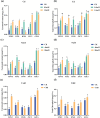Abiotic stress-induced changes in Tetrastigma hemsleyanum: insights from secondary metabolite biosynthesis and enhancement of plant defense mechanisms
- PMID: 39725878
- PMCID: PMC11673374
- DOI: 10.1186/s12870-024-05975-9
Abiotic stress-induced changes in Tetrastigma hemsleyanum: insights from secondary metabolite biosynthesis and enhancement of plant defense mechanisms
Abstract
Tetrastigma hemsleyanum, a traditional Chinese medicinal plant with anti-inflammatory, anti-cancer, and anti-tumor properties, faces increasing abiotic stress due to climate change, agricultural chemicals, and industrialization. This study investigated how three abiotic stress factors influence antioxidant enzyme activity, MDA levels, DPPH free radical scavenging capacity, chlorophyll, carotenoids, active compounds, and gene expression in different T. hemsleyanum strains. The comprehensive evaluation indicates that the ZJWZ strain holds potential as a preferred parental material for future resistance breeding. Furthermore, PAL gene expression was strongly positively correlated with flavonoid and phenol contents, highlighting its role in the stress response through the phenylpropanoid-flavonoid pathway. This study contributes to the standardization of the production and breeding of superior strains of T. hemsleyanum. It also lays the foundation for investigating how plants react to environmental stressors.
Keywords: Tetrastigma hemsleyanum; Environmental signal response; Phytochemical composition; Plant growth and development; Stress resistance.
© 2024. The Author(s).
Conflict of interest statement
Declarations. Ethical approval: Not applicable. Consent for publication: Not applicable. Clinical trial: Our study was not a clinical trial. Competing interests: The authors declare no competing interests.
Figures












Similar articles
-
Transcriptome profiling reveals candidate flavonol-related genes of Tetrastigma hemsleyanum under cold stress.BMC Genomics. 2019 Aug 31;20(1):687. doi: 10.1186/s12864-019-6045-y. BMC Genomics. 2019. PMID: 31472675 Free PMC article.
-
Revealing quality chemicals of Tetrastigma hemsleyanum roots in different geographical origins using untargeted metabolomics and random-forest based spectrum-effect analysis.Food Chem. 2024 Aug 15;449:139207. doi: 10.1016/j.foodchem.2024.139207. Epub 2024 Mar 31. Food Chem. 2024. PMID: 38579655
-
The influence of prolonged but low intensity blue light on the physiological properties of root tubers and the accumulation of flavonoids in Tetrastigma hemsleyanum Diels et Gilg.Plant Physiol Biochem. 2024 Aug;213:108824. doi: 10.1016/j.plaphy.2024.108824. Epub 2024 Jun 11. Plant Physiol Biochem. 2024. PMID: 38936072
-
The research progresses and future prospects of Tetrastigma hemsleyanum Diels et Gilg: A valuable Chinese herbal medicine.J Ethnopharmacol. 2021 May 10;271:113836. doi: 10.1016/j.jep.2021.113836. Epub 2021 Jan 16. J Ethnopharmacol. 2021. PMID: 33465440 Review.
-
A comprehensive review on traditional uses, chemical compositions, pharmacology properties and toxicology of Tetrastigma hemsleyanum.J Ethnopharmacol. 2021 Jan 10;264:113247. doi: 10.1016/j.jep.2020.113247. Epub 2020 Aug 12. J Ethnopharmacol. 2021. PMID: 32800929 Free PMC article.
References
-
- Lin W, Chai Q, Wang W, Li Y, Qiu B, Peng X, Lai T, Huang J, Lin Z. A novel method for geographical origin identification of Tetrastigma Hemsleyanum (Sanyeqing) by near-infrared spectroscopy. Anal Methods. 2018;10(25):2980–8.
-
- Dong S, Zhou M, Zhu J, Wang Q, Ge Y, Cheng R. The complete chloroplast genomes of Tetrastigma hemsleyanum (Vitaceae) from different regions of China: molecular structure, comparative analysis and development of DNA barcodes for its geographical origin discrimination. BMC Genomics. 2022;23(1):620. - PMC - PubMed
-
- Dai Y, Shen Z, Liu Y, Wang L, Hannaway D, Lu H. Effects of shade treatments on the photosynthetic capacity, chlorophyll fluorescence, and chlorophyll content of Tetrastigma Hemsleyanum Diels et Gilg. Environ Exp Bot. 2009;65(2–3):177–82.
-
- Guo WL, Yang ZQ, Hou ZN, Hou Z, Hu J. A comprehensive review of a Chinese folk herbal species Tetrastigmae hemsleyanum with multiplicity of pharmacological effects. Chin Traditional Med J. 2019;1(2):1–19.
MeSH terms
Substances
Grants and funding
LinkOut - more resources
Full Text Sources

